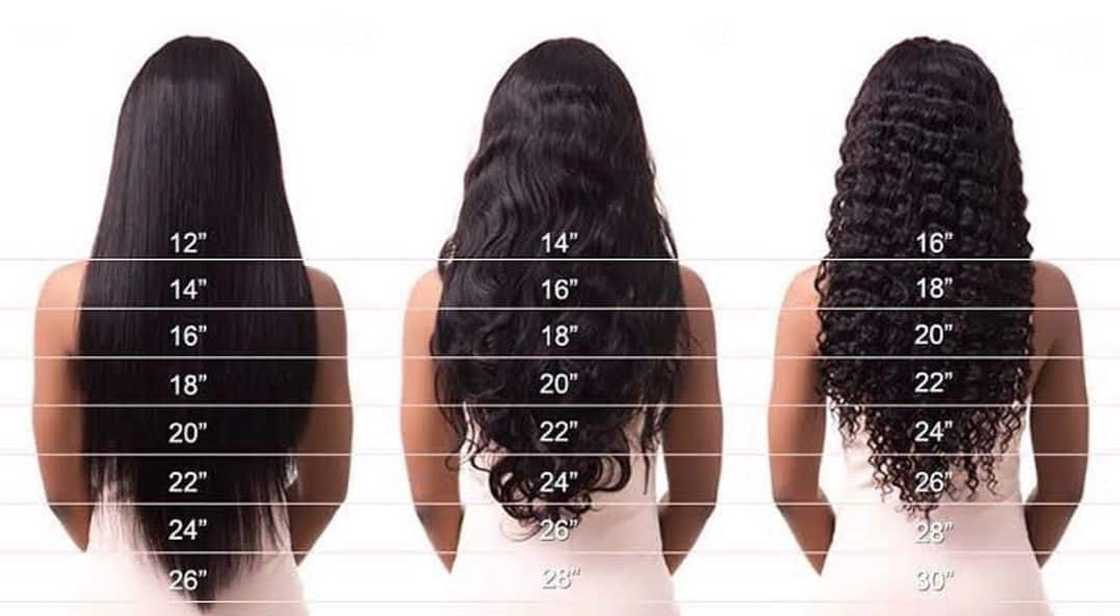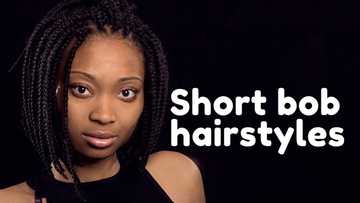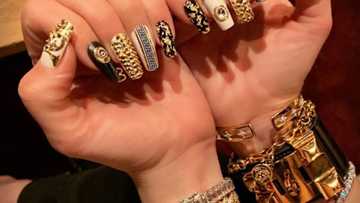Hair length chart: Understanding types of hairs and and how to measure
Do you often stand in front of the mirror wondering when your hair will be long enough for your preferred hairstyle? Hair length charts are essential to keep track of how your hair is growing. Also, hair length charts are a great reference point when discussing your preferred style with your hairdresser. With it, the degree of confusion is highly reduced. So, what are hair length charts, and how do they work?

Source: Instagram
Hair length charts are becoming more useful to fashionistas today. With different hairstyles in town, hair length charts help users determine if their strands are long enough for their preferred style. Also, hair length charts will let them know how much hair extension they need to complement their natural hair.
Hairs and their types
While strands type and texture are two conversations that often go hand in hand, everybody's hair belongs to a group. According to Andre Walker, the first person to categorise hair, there are four different types, and these are discussed below:
Straight hair
This is also known as Type 1 hair. A hair chart length of this type shows that it is just as the name describes: straight. Usually, straight strands look flat and limp because the natural oil that the scalp produces can easily coat itself.
Wavy hair
The wavy hair is also known as Type 2 hair, and it is subdivided into 2a, 2b, and 2c. A wavy hair is straight with some waves. Whether a person has Type 2a or Type 2c hair is dependent on the total waves in their straight strands.
Curly hair
Curly hairs are full of waves. Before you can conclude that you have this type, your strands must be twisted around themselves. This type is also known as Type 3 hair and based on the curly hair length chart, it is further divided into 3a, 3b and 3c, depending on the degree of curls.
Coily hair
This type is springy and also known as Type 4 hair. Also, it can be called kinky-curls and Zigzag. However, this type is an upgrade of curly hairs and is usually very tight, almost like a knot. Like the rest of the hair types, the coily strands can be Types 4a, 4b, and 4c, depending on the texture and tightness of curls.

Source: Getty Images
What factors determine your hair type and texture?
Notably, the type of strands you have determines how you will treat it. But, at the same time, the degree of absorption varies. For instance, straight strands absorb moisture and hair products better than others, while the coily ones do not absorb moisture or any hair product. Nevertheless, two things fundamentally determine your hair type and texture: your genes and the environment where you find yourself.
Genetics
The amount and types of hair genes you inherit from your parents play a crucial role in your hair type. For example, if your parents have curly strands, you may conclude that your hair is curly, although this is not always true because your parents may also have other hair genes in their DNA. If you picked up the wavy hair gene, you might have wavy hair while your parents' are curly.
However, do not forget that human hair is not straightforward; people can have different types on their heads. In a nutshell, your strand texture can be thin, thick, or coarse, depending on your inherited genes.
Environment
Your strands could react to the atmosphere in your environment. When this happens, you may find some of your hair strands laying around even though you haven't visited the salon. Also, if you step into the rain, you may see your straight hair become curly or wavy.
Besides, other factors that can influence your strands type and texture are weather conditions, age, and the hair product you apply.
How do you measure your hair length?
A hair length chart for men and women is useful when determining hairstyling and face definition. Nevertheless, to measure your strands, you can pull them to the front, sides, or back. Below are simple steps to estimate the size:
To the front
This method is mostly used for short hairs. To do this, you pull the strands to the front of your face. Your hair length is then determined based on how well it touches your eyebrows, nose, lip, or chin.

Source: Getty Images
To the sides
This method works well for medium long hair. A medium long hair can be ear, jaw, or shoulder length. Importantly, the strands must touch any of these body parts to be considered medium long.
To the back
This type is better considered as a hair length chart for women. Anyone who can boast of long hair should measure it against their back. This measurement covers the length from the shoulder to the floor. Specifically, your hair length could be armpit, waist, hip, thigh, knee, or floor length.
A hair length chart for black girls will show how long the strands on their head is. So, at what length is hair considered long? If the strands go beyond your shoulders, you may pride yourself on having long strands.
Note that when trying to use a wig hair length chart, wigs have different strands types nowadays. Although most wig lengths are between 8 and 30 inches, your choice may depend on your face shape, body shape, and height.
What hair length is most attractive?
Beauty is in the beholder's eye, but sometimes, the length of your strands might be the reason someone thinks you are gorgeous. Most men believe that females are more attractive when they wear their hair long. However, women may also feel that short hair length is best for a man.
A hair length chart is useful whenever you want to measure your strands' length correctly. With that, you know what your hair is called and the appropriate length of extension you need for whatever style you are considering.
READ ALSO: 50 traditional dresses with pictures in South Africa 2021
Briefly.co.za recently discussed traditional dresses in South Africa. According to the post, the country is one of the most culturally endowed countries in Africa.
South African traditional dresses have become the epitome of nearly all occasions. The diversity in these outfits has made it more possible for people to attend events. Find out from the post various dress options that you can opt for.
Source: Briefly News







